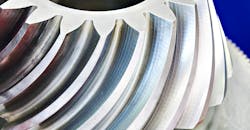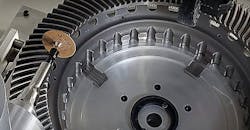It’s impossible to design a machine part without ‘burrs.’ In fact, it’s only after the part has been designed and a process has been selected for producing the part that any issue involving burrs on the part become apparent. And yet, those burrs have to be removed for the part to function as it’s designed to do.
Experienced part designers have learned that even if a deburring process is included during the manufacturing plan, the possibility of additional burrs developing remains. In many cases, unexpected deburring is needed in a hurry. Until a better solution can be implemented, a temporary hand deburring solution usually works as a remedy.
If you or your team continue to adopt hand deburring as a solution such a situation, then poor finish quality, part inconsistency, a high scrap rate, and employee turnover are likely significant issues for your business. For hand deburring to achieve desirable results, considerable training must be provided. Maintaining a reliable pool of hand deburring workers is tough, and you are always training someone new.
James Engineering founder James Richards explained that manufacturers tend to accept hand deburring as a satisfactory fix, despite the drawbacks. “I watched a demonstration of a company’s best hand-deburring specialist as they processed an airplane cylinder head. It was impressive to watch; 17 minutes later, the specialist was done.
“I said, ‘Great! Three cylinder heads an hour with a three-minute turn around, and you can do 21 heads in a day; Right?’ ‘Oh no,’ was his reply; “We do seven heads a day.”It is rare to find someone who can maintain production anywhere close to a theoretical or averaged cycle time. On the other hand, the positives of hand deburring are that you can always find a way to complete the job.
Manual gear-deburring machines
Gear-deburring machines require an operator to set up each deburring tool manually. Early models used individual tools, usually an air tool holding a 3-inch diameter grinding wheel on a weighted, hinged lever. If deburring of simple gears is what you need, those early machines are still effective. However, since such machines generally use only one tool to chamfer gear teeth, the exit burrs need to be filed off using a manual lathe, or a similar method, before this deburring method can be used effectively.
By the 1980s, companies like James Engineering had added as many as four tools to these manual-machine designs, so more tools to be used, resulting in a quicker cycle time. Removing exit burrs using this new manual-machine design was no longer a separate operation. This multi-tool advancement changed everything.
In the late 1980s, James Engineering added its automatic wheel-wear compensation control feature and a unique, raised-gear holding capability that further distinguished its early manual-machine models. Together, these additions made flipping of gears an unnecessary step in the manual-machine finishing process.
Gears could finally be removed from a gear cutter and put onto the James Engineering manual gear-deburring machine. Tool number one is set up manually to remove the exit burrs of the gear. Just a few degrees behind this operation, chamfer tools number two and three can be set up to put chamfers on both sides of the gear. Tool number four, an abrasive brush, can be used to remove the micro-burrs of the chamfered gear teeth, completing four operations and producing a completely finished part in a single cycle.
As the early, manual machine deburring systems gained popularity, people found that each tool took as long as five minutes to set up, test, adjust the set-up, and retest, and then run a batch of parts. These machines would run cycles of 15 to 30 seconds per side for gears measuring six inches in diameter, or smaller. Larger gears might have a cycle time of a minute per side. These types of manual deburring machines are still used today.
One drawback to a manual-machine deburring system is that it requires an operator with skill and knowledge of how to perform the manual set-up for each gear type. Another problem becomes clear if you are a job shop or production operation with multiple short-run batches. In those cases, you will spend a significant amount of time each day setting up a manual machine for new parts.
A common scenario is that a business wants to set up six parts each day on a manual machine. The operator spends 15 minutes setting up the machine, then 10 to 20 minutes getting the set-up to produce the required part quality by tweaking the set-up. On the surface, this timing doesn’t seem bad; but losing three hours of an eight-hour shift to set up the machine means you’ve lost 37 percent of each day’s production time.
Today, we are in a digital, computer-controlled world where operators just want to download a program and run parts.
Not all manual gear deburring machines are the same. Many use pivoting axes, which are difficult to set up to achieve the desired results. Moving a pivot point for multiple axes means you have shifted all the axes of the tool you are trying to set up along multiple planes at once — a complex visual and spatial problem for an operator to solve quickly.
Other machines introduced small openings, which make it difficult to see what is going on during the set-up. If this method appeals to you, the best advice is to compare brand features, and do your homework.
Focused Deburring, plus chamfering, finishing
The introduction of James Engineering’s MAX System™ gave rise to the phrase, Focused Deburring™. The MAX System eliminates the need for skilled operators to manually change set-ups from one part to another. All the machine operator needs to do is select the correct recipe from the database; press enter; load the part into the machine; then press cycle start. Run one part or 100 parts; select-enter-cycle start, and run another one or 100 parts.
To run six different part types during an 8-hour shift, for example, takes less than 30 seconds to set up all six parts. The MAX can run six or 60 different parts in the course of one 8-hour shift and lose only a couple minutes total time to select-enter-cycle start, as needed.
Once a part has a recipe, you never need to create another one; and every time you run a recipe, the part that is produced is identical. The recipe for a spur gear takes just five minutes to create, and anyone can be trained to do it. No CAM software or even CAD model is required. Everything is done from the MAX System machine interface.
Today’s MAX System is comprised of tool towers attached to the machine’s roof. Each model comes standard with one to four towers, and each can use up to six axes of fully synchronized motion. Each tower can have up to three tools capable of 1,000-ipm rapid travel, which makes quick work of complex motions.
Additionally, the machines can be fitted with a 1,000-rpm rotary table. This nets an impressive system where all axes and rotary tables are fully synchronized, and interpolation, threading, and repeating are easily manageable. This configuration enables the maximum amount of work to be performed simultaneously by each tower system and delivers a maximum amount of output in short cycle times.
These upgraded axes give each MAX machine a wide, three-dimensional tooling range and ability to deburr and finish surfaces no other multi-axes machines can match. In this patented design, all electric servos, ball screws, and linear motions are out of the work area, so toxic nanoparticles cannot affect these components’ daily operations.
The patented tool-head design of the MAX delivers precision, computer-controlled working forces behind its perishable tooling media and produces consistent, ultra-price edge and surface finishes. Active axes, along with automatic wheel-wear compensation control, allow a wide range of media to be applied with different, precise forces to every part as each tool head moves over different surfaces, performing multiple, distinct deburring and surface finishing processes.
In addition, the technology can create different-sized chamfers and edge radii to distinct areas of the same part, and apply these combined functions within a single cycle for precise quality and consistency, at extremely high throughput rates.
Along with its Focused Deburring, the MAX System delivers selective surface finishing for only those part surfaces manufacturers choose to finish. The MAX’s selective finishing abilities — to quickly process some part features and completely avoid others, without requiring part masking or special set-up adjustments — is a new option for the industry, especially for those who have leaned heavily on abrasive finishing.
Combining Focused Deburring, chamfering, and finishing allows the MAX System to work specific part-features. The advantages realized from Focused Deburring™, chamfering, and finishing are: \
1) reduced cost-per-part,
2) least amount of energy consumed per part, and
3) greatest number of parts produced per perishable tool use. By precisely deburring and finishing only surfaces you want processed, the MAX System saves time, consumables cost, and energy, for MAXimum efficiency.
John Seaward Jr. is a communications specialist at James Engineering, a family-owned deburring and chamfering machine shop in Broomfield, Colo.
About the Author
John Seaward Jr.
Communications Specialist
John Seaward Jr. is a communications specialist at James Engineering, Broomfield, Colorado.

